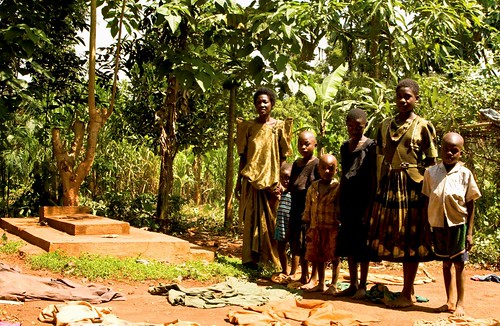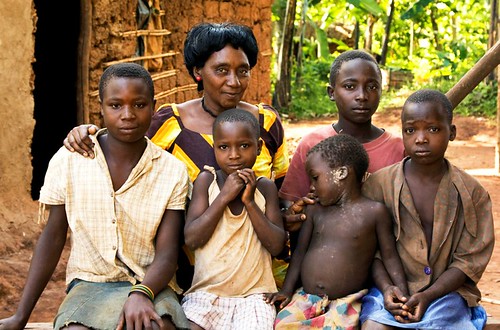Ed with his wife, Robyna
I would like for you to meet some of the people in the houses surrounding the pastor’s, they represent a typical Ugandan village. As I previously mentioned, the rural areas are almost entirely devoid of persons between about 20 and 50, mostly lost to HIV/AIDS and the promise of urban work.
This is Jumula and Nasubuga. They live two doors down from the pastor. He is blind; that is his stick resting to the left that helps him to slowly get around some. His wife is almost deaf and is unable to stand up right. She is resting elegantly here on her floor, but when she moves she does so at a perfect right angle, her head and upper body hovering facing the ground. Several of their grandchildren were at school, while others were standing outside when I visited; there wasn’t space for them in the tiny room filled with four adults.
These are the disabled couple’s children, one concrete and a few dirt graves behind their home; the dead parents of the children the elderly now look after.
Topispita lives directly across from the pastor. Her husband died from AIDS and infected her. The illness is significantly affecting her health, including her mental abilities. Fortunately, not all of her children are gone; she lives with her son, his wife and their six children. The family has extreme difficulty attending to her health needs, however, which require clinic visits, medicine, and alleviating her daily symptoms of pain and delusions during which she injures herself.
This is Nasabu, who was apologetic to me for not feeling well; she was suffering from malaria. She is seated here proudly in front of her home, which is directly behind
This man lives two houses away from Nasabu. When I visited he had recently returned from a few weeks hospital stay to treat complications relating to AIDS. Some of his children have died from the virus, so he and his wife, whom we can probably presume is also positive, look after 10 orphaned grandchildren.
This building is just to the right of the couple above. The three doors lead to three small rooms rented by three families. The pastor believes the woman to the right is HIV positive, but she won’t get checked. She has seven children. The pastor also thinks the woman living in the middle room has AIDS. She has eight children, but will also not get tested. He does not know well the family that lives to the left.
They call her
These are some of the children and grandchildren of a widow that lives across from the
All of the people pictured above live within approximately 50 yards of each other. The official national HIV rate is around 6%. Laughable, isn’t it? If it’s anywhere close to that it’s only because so many of the sick are dying. The intense ruin, misery and death you hear about on the radio, watch on the news and read in magazines about AIDS in


















Ok totally off topic but what camera are you using? I know its not just the camera that makes the pixs amazing, im just wondering what tools your working with? Im new to photography. thanks!
ReplyDelete-h